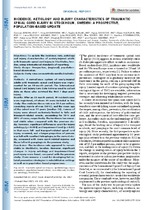| dc.contributor.author | Joseph, Conran | |
| dc.contributor.author | Andersson, Nina | |
| dc.contributor.author | Bjelak, Sapko | |
| dc.contributor.author | Giesecke, Kajsa | |
| dc.contributor.author | Hultling, Claes | |
| dc.date.accessioned | 2018-10-23T12:03:38Z | |
| dc.date.available | 2018-10-23T12:03:38Z | |
| dc.date.issued | 2017 | |
| dc.identifier.citation | Joseph, C. et al. (2017). Incidence, aetiology and injury characteristics of traumatic spinal cord injury in Stockholm, Sweden: a prospective, population-based update. Journal of Rehabilitation Medicine, 49: 431–436 | en_US |
| dc.identifier.issn | 1650-1977 | |
| dc.identifier.uri | http://dx.doi.org/10.2340/16501977-2224 | |
| dc.identifier.uri | http://hdl.handle.net/10566/4152 | |
| dc.description.abstract | OBJECTIVES: To update the incidence rate, aetiology
and injury characteristics of acutely-injured adults
with traumatic spinal cord injury in Stockholm, Sweden,
using international standards of reporting.
Study design: Prospective, (regional) populationbased
observation.
SUBJECTS: Forty-nine consecutively enrolled individuals.
METHODS: A surveillance system of newly-injured
adults with traumatic spinal cord injury was implemented
for an 18-month period. The International
Spinal Cord Injury Core Data Set was used to collect
data on those who survived the first 7 days postinjury.
RESULTS: After an 18-month period, 49 incident cases
were registered, of whom 45 were included in this
study. The crude incidence rate was 19.0 per million,
consisting mainly of men (60%), and the mean age
of the cohort was 55 years (median 58). Causes of
injury were almost exclusively limited to falls and
transport-related events, accounting for 58% and
40% of cases, respectively. The incidence has remained
stable when compared with the previous study;
however, significant differences exist for injury
aetiology (p = 0.004) and impairment level (p = 0.01)
in that more fall- and transport-related spinal cord
injury occurred, and a larger proportion of persons
was left with resultant tetraplegia, in the current study,
compared with more sport-related injuries and
those left with paraplegia in the previous study.
CONCLUSION: The incidence rate appeared to remain
stable in Stockholm, Sweden. However, significant
changes in injury aetiology and impairment-level
post injury were found, compared with the previous
study. There remains a need for developing fall-related
prevention strategies in rehabilitation settings
as well as in population-based programmes. | en_US |
| dc.language.iso | en | en_US |
| dc.publisher | Foundation for Rehabilitation Information | en_US |
| dc.rights | This is an open access article under the CC BY-NC license. | |
| dc.subject | Traumatic spinal cord injury | en_US |
| dc.subject | Epidemiology | en_US |
| dc.subject | Injury prevention | en_US |
| dc.subject | Population-based cohort | en_US |
| dc.subject | Core data set | en_US |
| dc.subject | Incidence | en_US |
| dc.subject | Aetiology | en_US |
| dc.subject | Stockholm | en_US |
| dc.title | Incidence, aetiology and injury characteristics of traumatic spinal cord injury in Stockholm, Sweden: a prospective, population-based update | en_US |
| dc.type | Article | en_US |
| dc.privacy.showsubmitter | FALSE | |
| dc.status.ispeerreviewed | TRUE | |

